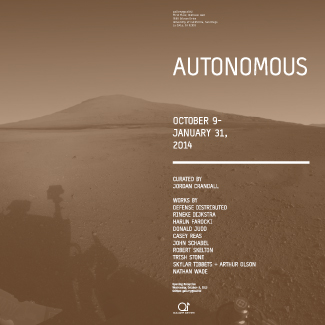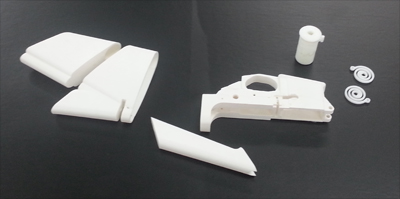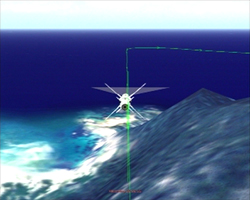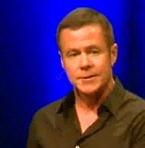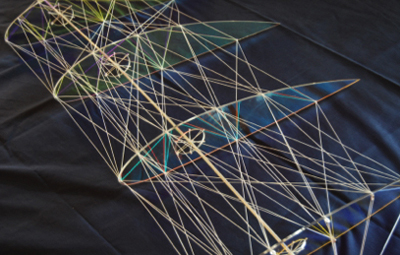When Art Becomes Autonomous
New Exhibition in UC San Diego’s gallery@calit2 Ponders Meaning of Autonomy
San Diego, Oct. 2, 2013 -- What does autonomy mean in an age when technology is radically transforming the ability of objects and even ideas to have a life of their own – from smart cars, to viral videos?
|
“Aspects of our world that were formerly considered inert are becoming endowed with communicative ability and intelligence,” said Crandall. “Capacities of sensing, processing, communication and actuation are woven within and across the boundaries of objects, spaces, and systems at multiple scales… often bypassing the sensory and cognitive capacities of humans. So to what extent can we regard these forms as ‘autonomous’?”
Groping for an answer to that question, Crandall pulled together works by a dozen artists and researchers. The works represent a dizzying array of concepts that approach the concept of autonomy from very different angles. Some of the installations are interactive, some not. Some of the works are by dyed-in-the-wool artists, while others originated in the minds of scientists and technologists.
Take MIT’s Skylar Tibbits and Arthur Olson of The Scripps Research Institute in La Jolla. Together, they produced Autonomous Mass-Assembly. The work is the latest in a series of pieces based on the notions of self-selection and self-assembly. The 2013 installation uses an agitation machine to energize roughly 240 pieces modeled on the polio virus capsid. Each autonomous piece appears to assume a life of its own as it self-assembles with other pieces into closed, molecular-type structures. Certain parts appear to be attracted to others (mirroring patterns in life with complementary chemical traits and the left- and right-handedness known as chirality).
|
Another 2013 piece, Liberator, is an object fabricated using 3D printing – the rapid prototyping of a solid object by building it up from melted polymer, one layer at a time. The design originated with Defense Distributed, an open-source organization that designs, develops and publishes design schematics that can be downloaded and reproduced with a 3D printer. In May, Defense Distributed made headlines worldwide when it released the files for printing the Liberator pistol, the first, fully 3D-printable gun made widely available online.
|
The autonomous nature of modern weapons technology is also on display in German artist and film director Harun Farocki’s video piece, Auge/Maschine II (Eye/Machine II in English). Produced in 2002, the 15-minute video integrates military and civilian material – some real, some imagined using special effects – underscoring how computer vision has overtaken human sight, especially as a witness to history, turning the traditional man-machine distinction into an eye-machine divide.
“Intelligence is no longer limited to humans,” observed Crandall. “Human vision cedes to the power of global and tactical warning systems, surveillance apparatuses, and smart weaponry.”
|
“Judd considered his sculptures to be specific and autonomous, to a certain extent, and the relationship between the sculptures and their fabrication process is key to understanding this,” explained the show’s curator. "In transferring a significant level of decision-making regarding details to his fabricators, Judd added a dimension of specificity that was unique to each work, in ways that foregrounded the role of craftsmanship. This ‘transference’ suggests new approaches to materiality in art and objecthood today. It offers new insights into the relationship between art work and the production process.”
Other works on display in the gallery@calit2 include:
- Rami: Givati Brigade, Rotem Regiment, Golan Heights, Israel (2000), by Rineke Dijkstra;
- Network B (2009), generative software by Casey Reas;
- Untitled (Passenger #3), from a series of photographs of airline passengers, by John Schabel; and
- Untitled, What Followed Was Amazing Bliss (2013), a video project with custom software by Nathan Wade.
Two UC San Diego works will also be exhibited. The first is View from Curiosity, August 2012, for which Trish Stone, an artist who performs visualization research in the Qualcomm Institute, manipulated an image from NASA/Jet Propulsion Laboratory at Caltech to produce large ink-jet prints.
|
“Tensegrity structures could be deployed into space as light-weight antennae, mirrors and satellites, or be used for airplane wings, water craft or anything else that needs to change shape to reduce drag,” said Skelton. “Built-in actuators, sensors and power storage devices make tensegrity structures a very attractive alternative to conventional designs for material systems.”
Related Links
Media Contacts
Doug Ramsey, 858-822-5825, dramsey@ucsd.edu

